17 Ecommerce Email Marketing Automation Ideas For Your Store
The email marketing strategies for ecommerce you HAVE to be using
What ecommerce email marketing automation flows do I need for my store? In short, as many as possible that are applicable to your store!
The amount of options in terms of flows and segmentations based on consumer behaviour is nearly endless and means you need to keep A/B testing at every possible opportunity! Below are a 17 variations of Ecommerce email marketing automations that will increase revenue for your store nearly instantly and significantly more so if you have an already built up email list and a large amount of inbound traffic to your store.
Pre Purchase
Ecommerce email marketing automations to make your customer convert to purchase
These are the email marketing flows that are encountered by users before they have made a purchase in an effort to get them to purchase. These flows have a purpose which is:
- Give potential customers that one last push over the line that they often need
- Get people on your email list so you can actively communicate with them in the hopes of turning them into a customer.
- Push potential customers further along your funnels to get them closer to their first purchase, this is often the hardest thing to do
- Build trust and authority with potential customers, turn people who don’t know/trust you into people who know you has a trustworthy authority in your space.
Welcome Series
The welcome series email automation is one of the three pivotal flows that must be installed before all others, the welcome flow is especially
useful for several reasons.
Build Your Email List
Website visitors won’t simply give you their email address and details, an exchange of value needs to take place. This is the fundamental definition of marketing as a whole.
This is why you see pop ups offering a discount or free information in exchange for an email address or even more information, a google search is a great way for some quick research on pop ups.

The larger your email list, the larger scale for revenue you have as you own a channel that you can message at any time, unlike social media ads.
Turn Potential Customers into Paying Customers
Turning potential customers into actual, paying customers is traditionally quite expensive and difficult, think about the last time you bought a product from a brand for the first time and it was of some expense.
- Were you sure it was the right choice?
- Did you fear you may regret it?
- Did you have a brand/product you had used before that felt like the safer, known choice?
- Have you bought from a new brand and not liked it?
These are the reasons that it’s so expensive and difficult to gain new customers, especially for ecommerce/online shopping.
This is why you provide something of value to exchange and have the welcome series, to build relevance & authority with the potential customer, to gain familiarity and trust, or for a store to minimise risk by providing a discount.
Once someone becomes an existing customer, they’re statistically over 3x cheaper to get them to purchase again, this is where other flows come in.
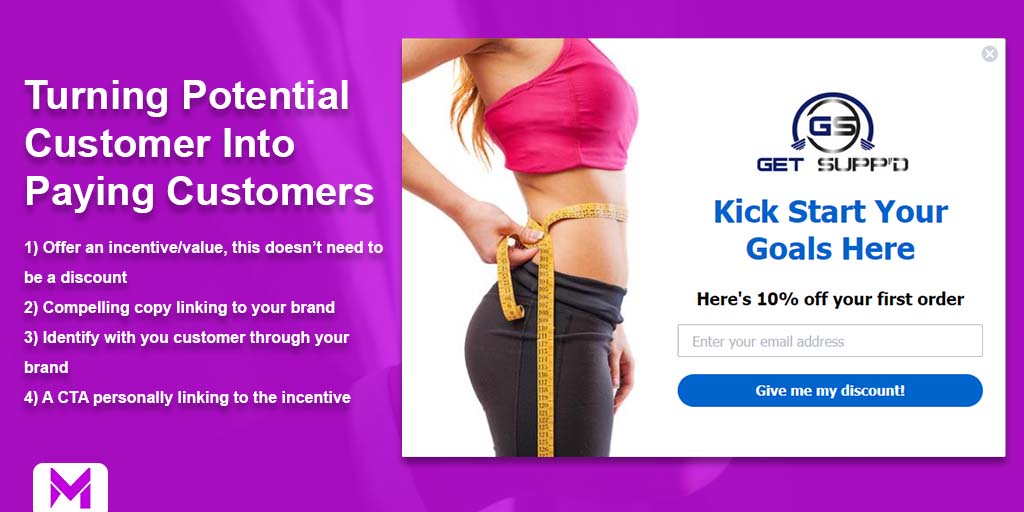
Browse Abandon
The browse abandon flow is for users who’s data you already have, your email marketing software e.g. Klaviyo, tracks when customers visit your website and their behaviour. If they look at a certain product, you can then send them an email reminding them that they looked at this product.
Some may consider this flow to be a little creepy in the way it tracks users, but it has been proven to generate further revenue, especially if it’s a product that someone has viewed multiple times and you offer them a 10% discount for example, it may give them the final push over the line that they need.
Abandon Cart
The abandon cart ecommerce email marketing automation is the most well known of the ecommerce email marketing flows, it’s often confused with the abandon checkout as Shopify has a different definition to other ecommerce platforms e.g. Bigcommerce.
The abandon cart is when a customer, who already has a profile has put an item in their cart, then leaves the store without purchasing.
This can then trigger a flow to bring the user back to the store to finalise their purchase, this is expected to convert more often than the browse abandon simply because the lead is warmer, the user has signalled a stronger intent to purchase given they actually added it to their cart.
- One is a clear winner
- There’s enough statistical evidence to calculate a winner with confidence.
You can test just about any element of an email, but subject lines are the focus here.
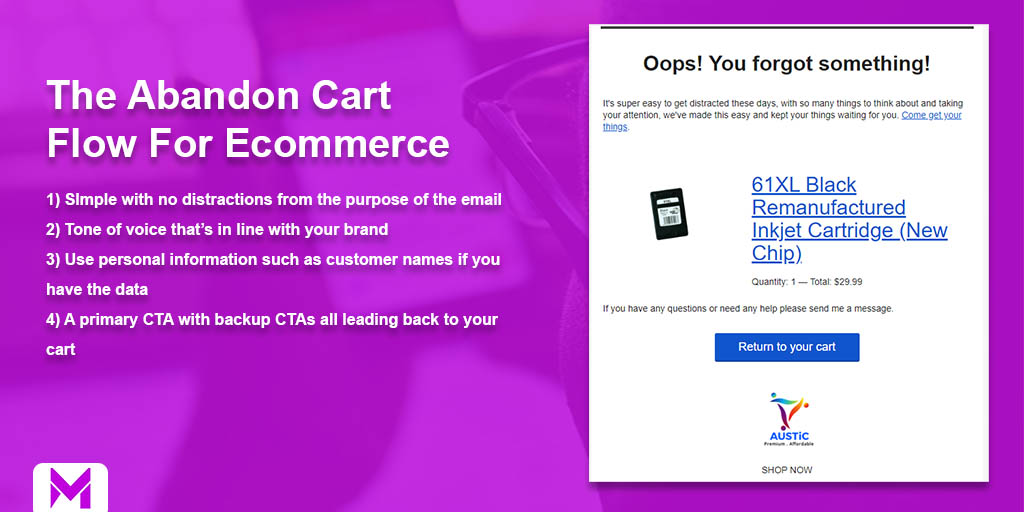
Abandon Checkout
The abandon checkout flow is the final and the highest revenue generating flow of all.
This flow is when a user gets to the checkout, enters their details and then abandons their purchase, often this can be because of second thoughts/doubts or even as simple as getting distracted.
This flow can be 2-4 emails and is aimed at getting them over the line to complete the purchase, this is the highest converting because it signals the strongest purchase intent by far and are at the final step of the purchase funnel.
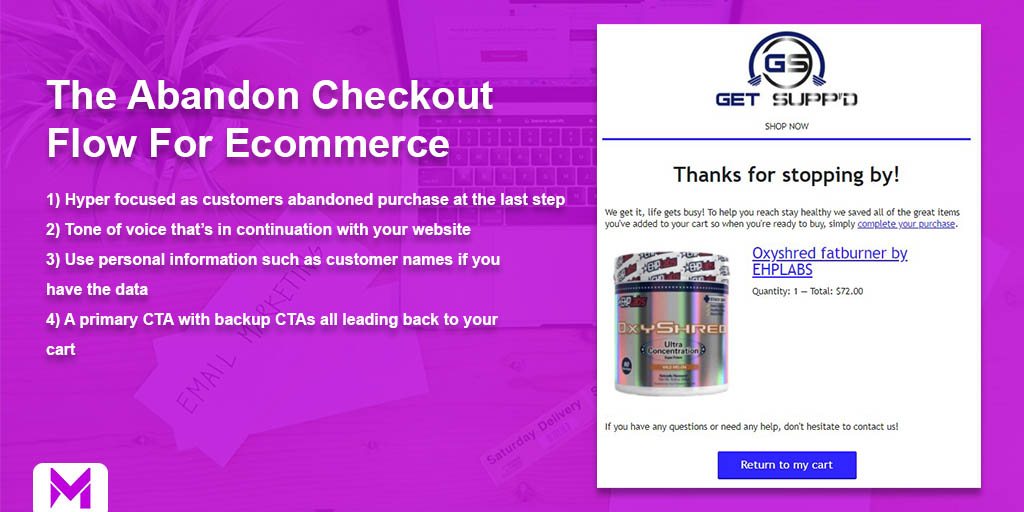
Post-Purchase
Ecommerce email marketing automations to help your brand and give customers that extra special experience
These are the flows aimed at increasing goodwill and/or stacking further value once the purchase has been completed.
This is where you build authority and trust between the customer and your brand and where the real business growth happens, also known as the back end.
Thankyou Flow
The Thankyou ecommerce email marketing automation may often be a single email, but is important in order to build rapport and trust with customers.
If someone has bought something from your Shopify or Bigcommerce store for the first time, they have taken a calculated risk with your business, this is a prime opportunity to build on that initial trust.
The thankyou flow may be a simple message saying thankyou or even a small reward or discount (be careful not to use too many discounts, it may cheapen your brand or your customer base may come to expect it)
There are also two strategies around the thankyou flow, you can either send a nice email in the same style as all your other emails with your branding look & feel, or you can make it a simple, plain HTML (blank email just like the ones you send at work) which can be from the owner of the business owner personally.
Branded Email
Doing a branded email as a thankyou is a good idea for large businesses, larger stores that generate significant revenue and are larger brands, or if your product is very impersonal, see below for examples.
Plain HTML
A plain HTML email is highly intimate and personal, it gives the impression that you are receiving an email directly from a person rather than a business, a HTML email is one that is free of branding and is simply just plain text.
If your business is smaller or your products are more intimate these may be worth a try, in the information age a personal thankyou is a rarity.
The key to this type of thankyou flow is:
- No branding
- Little to no images (an image of the store owner in the signature is fine)
- Speaking in first person language (me, I etc.)
Try A/B testing the two of them and see what performs better, as with anything in email marketing, there are few hard and fast rules to speak of.
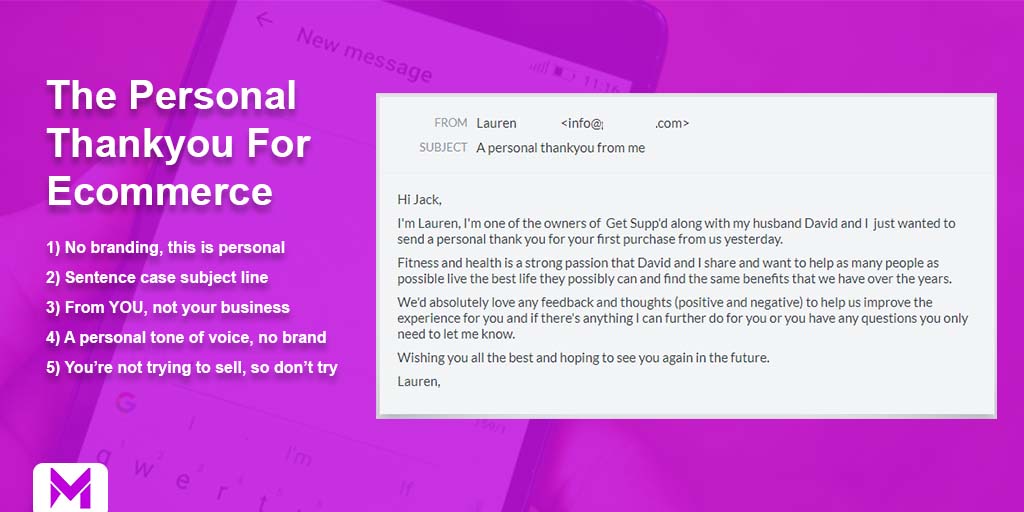
First Time Customer vs Repeat Customers
For this flow, it’s vital that you ensure you don’t lose that personal touch in the eyes of your customers, this means that you can’t send the same thank you message to your customers every time, it needs to be varied.
In order to ensure this, we typically have two messages, one for first time customers and another for repeat customers, this achieves two purposes:
- Gives customers that personal feeling that many larger businesses ack
- Gives first time customers that “special” feeling, vastly increasing their chances of coming back
Adding a discount code for a first time purchaser may also be an incentive worth split testing.
Education Flow
The education flow is another flow that’s not sales/revenue centric, this is another email automation flow that’s designed to build trust between your ecommerce store and existing customers.
This flow is especially important if you sell products that require instructions on how to use or how to care for to ensure it lasts, avoiding a bad experience and review for your store.
An education flow is best sent just before your store’s product is scheduled to be delivered so keeping in mind your delivery times is important.
Cross Sell
The cross sell email flow is another well known automation, it’s designed to increase the likelihood of further purchases from the customer after their initial purchase.
If you’re strategy is to increase revenue on the backend of the sales process or you use a loss-leader product then this becomes especially important.
It’s important for this to be centred around products that are complimentary to the original product e.g. if someone has bought a dress, you may want to show them some shoes or accessories that go with that dress. Don’t try to sell them hiking boots!
Another possibility is your most popular sellers if they are relevant to the original purchase
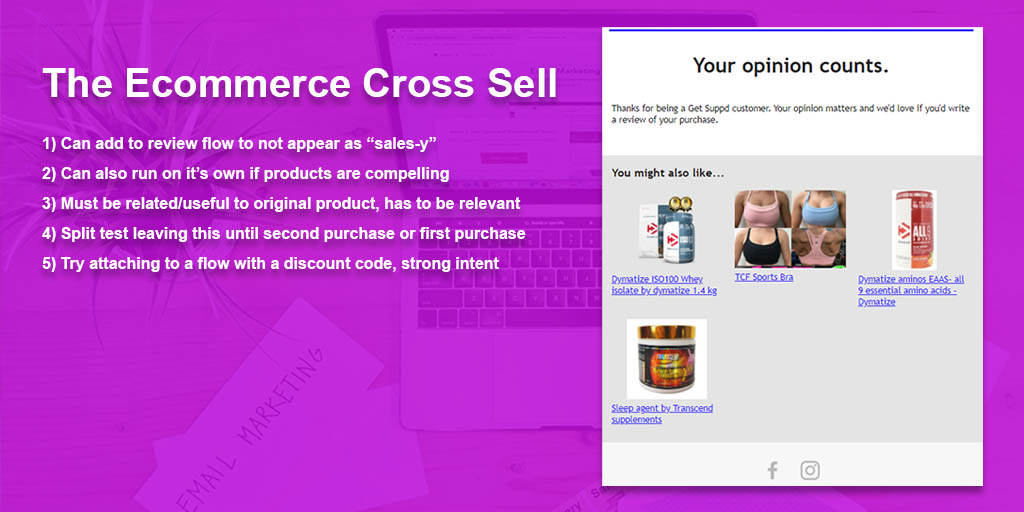
Upsell
The upsell email flow is another common automation that’s well known but implemented incorrectly. The purpose of the upsell email flow is to upgrade a purchase that a customer has made into a superior or more profitable product/subscription.
Like the cross sell email flow, if you have a loss leader product or also have high customer loyalty then the upsell email flow will work quite well as you have built authority/loyalty with your customers, then the opportunity will present itself for you to upgrade your offer to your most loyal customers once the time comes to either replenish or replace the original purchase.
This will need to be managed in combination with your replenishment flow.
Product Review
The product review flow is a great way to build your stores reputation and is an excellent way of building trust with customers who haven’t purchased from your store yet.
Everyone has checked reviews before making any semi-major purchases and the more reviews you have, the more likely your store is to get that all-important first-time purchase.
For review apps/software, we use Yotpo as it integrates with Klaviyo and allows us so set up a review flow, we often use only 2 emails as a part of this flow as we don’t want to annoy our customers.
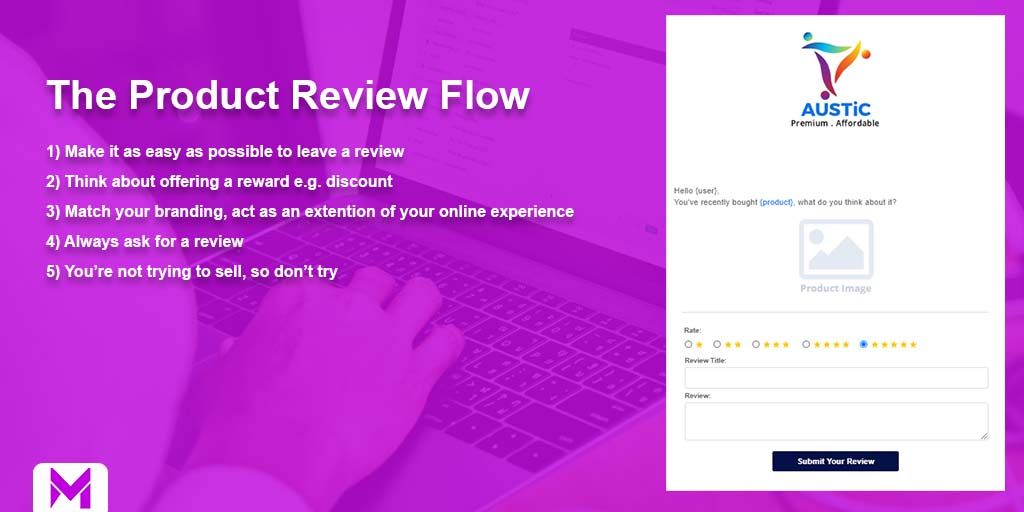
Renewal/Subscription
The product subscription/renewal ecommerce email marketing automation is a more niche flow for brands that specalise in informational products that require renewals of a subscription or membership of some description
This email flow is a good way of ensuring customers keep up memberships/subscriptions on a frequent basis as well as catering to customer needs, you can encourage responses or suggestions in your email flows in order to keep customer satisfaction high
Product Refill/Replenishment
The product refill/replenishment flow is a more niche flow for brands that specalise in consumable products or they have products that require consistent care.
This email flow is a good way of ensuring customer loyalty by taking care of their needs by sending them links to products they are likely to purchase again.
An example of how this flow would work is if a supplements store detects a customer has bought the same product twice in a relatively short period, from here you can program a reminder email when their product is scheduled to run out, reminding them to re-purchase, this can even be done with a discount to thank them for their loyalty.
Customer Winback/Sunset Flow
In order to keep your email list effective you must keep deliverability high, the most effective method to do this is to clean your email list regularly, one of the ways to do this is to run a customer winback or sunset ecommerce email marketing automation.
A customer winback flow is targeted towards segments of customers that have not purchase from you in some time, or have not responded in any way (opened/clicked) any of your email communications, having them remain on your email list lowers your authority in the eye of ESPs (Email Service Provider) so it makes sense to either re-engage or sunset their profiles.
This flow is generally triggered from the date of the customer’s most recent purchase, this varies depending on the business and the nature of the product itself, this can vary between 30-90 days for most products but can be longer or shorter for a more niche products
- A customer makes a new purchase or indicates that they are still interesting in receiving communications from your business
- A customer is removed from your email list
Post Event Attendance
Many businesses not only sell items online, but also run events whether they be in person or online, for this you can still use an ecommerce email marketing automation
If your business runs events, the experience shouldn’t stop when they leave your store or Zoom session.
Did they build a product? Was it an info seminar? Either way you now have warmed traffic that is now far more likely to convert into further purchases, if it was a product based event they can be directed to purchase related products that can be used to care for the initial product or a cross sell.
If it’s an info based event/seminar, this traffic can now be directed to buy a product based on your seminar/info session.
